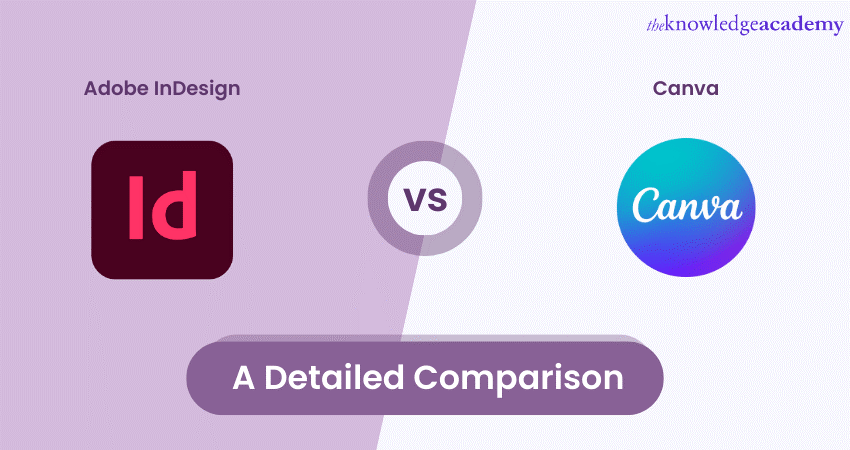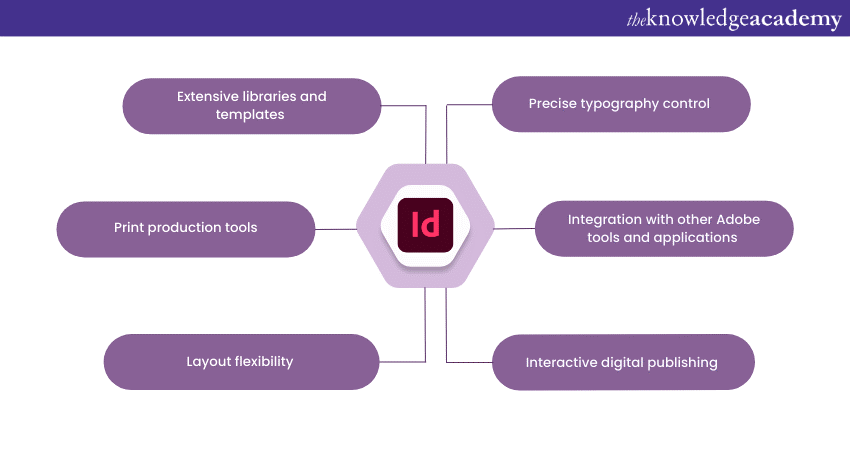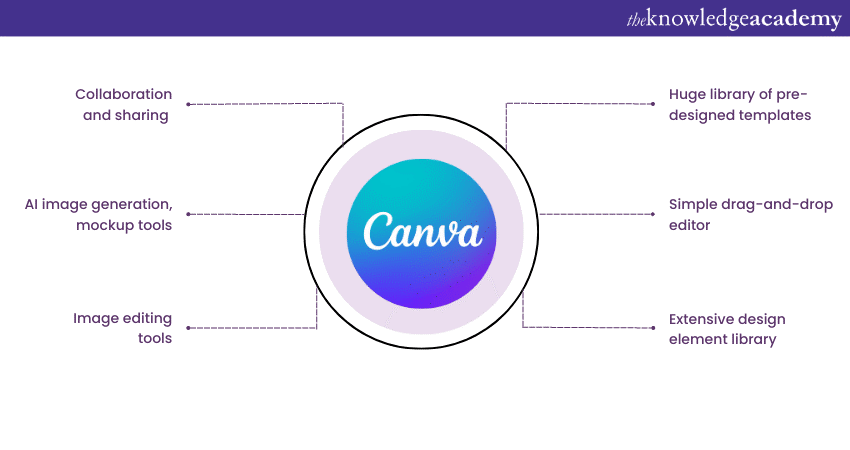We may not have the course you’re looking for. If you enquire or give us a call on + 1-866 272 8822 and speak to our training experts, we may still be able to help with your training requirements.
Training Outcomes Within Your Budget!
We ensure quality, budget-alignment, and timely delivery by our expert instructors.

When creating visually stunning designs, Adobe InDesign and Canva are two popular tools that often come to mind. Many designers might compare Adobe InDesign vs Canva to determine which is better. However, both platforms offer powerful features for designing various types of content, but they cater to different user needs and skill levels.
Adobe InDesign is a part of the Adobe suite of creative applications, whereas Canva is a web-based application for quick designs. Read this blog to learn and understand the differences between Adobe InDesign vs Canva and their various features.
Table of Contents
1) What is Adobe InDesign?
2) What is Canva?
3( Features of Adobe InDesign
4) Features of Canva
5) Adobe InDesign vs Canva: Key differences
6) Conclusion
What is Adobe InDesign?
It is a professional desktop publishing software used by Graphic Designers, Publishers, and marketing professionals. It is part of the Adobe Creative Cloud suite and offers extensive tools for creating print and digital designs, such as magazines, brochures, flyers, books, and interactive PDFs. InDesign provides precise control over layout, typography, and graphics, making it the go-to choice for complex and professional design projects.
Exceptional typographic control and layout flexibility are the two most prominent aspects of Adobe InDesign. Designers can fine-tune every aspect of typography, including font selection, kerning, tracking, leading, and hyphenation. This level of precision ensures that text elements are visually appealing and optimised for readability.
Users can easily create multi-page documents like magazines, brochures, and books. The software enables precise control over page margins, columns, and grids, allowing for the creation of complex and sophisticated layouts.

What is Canva?
Canva is a web-based design tool that aims to make graphic design accessible to everyone, regardless of their expertise. It provides a simplified and intuitive interface allowing beginners and non-designers to create visually appealing designs quickly and easily. Canva serves as an accessible Adobe InDesign alternative, particularly for beginners and small businesses, offering a simplified interface and pre-designed templates for quick and easy designs.
One of the most prominent features of Canva is its vast collection of pre-designed templates that cover various design categories, including social media graphics, presentations, posters, invitations, etc. Users can choose from various professionally designed layouts and customise them to suit their needs.
This feature is particularly beneficial for individuals or small businesses that may not have the resources or time to create designs from scratch. Canva also offers a rich library of design elements, such as images, illustrations, icons, and fonts. Users can easily drag and drop these elements onto their designs, allowing for quick customisation.
Learn Adobe tools from industry experts. Start today and improve your design skills with effective, in-depth Adobe Training!
Features of Adobe InDesign

Adobe InDesign offers comprehensive features that empower designers to create visually stunning and professional-grade designs. Here are some of the key features of Adobe InDesign that make it a powerful tool in graphic design.
a) Precise typography control: InDesign provides extensive typographic controls, allowing designers to manipulate every aspect of the text. It ensures precise and visually appealing typography by choosing fonts and adjusting kerning, tracking, and leading to controlling hyphenation and applying advanced OpenType features.
b) Layout flexibility: With InDesign, designers have the freedom to create complex layouts with ease. The software offers tools for managing multiple pages, establishing grids and columns, aligning objects precisely, and applying consistent styles through master pages. This flexibility enables the creation of sophisticated designs for print and digital media.
c) Seamless integration with Adobe Creative Cloud: InDesign integrates with other applications such as Photoshop and Illustrator. This integration allows designers to import and edit graphics or illustrations from these programs directly into their projects. It streamlines the design workflow and facilitates collaborative work across different design disciplines.
d) Interactive digital publishing: InDesign provides interactive features for creating engaging digital publications. Designers can incorporate multimedia elements such as videos, audio files, and interactive buttons to enhance the user experience in e-books, interactive PDFs, and digital magazines. Its interactive capabilities make it suitable for creating rich, interactive content for digital platforms.
e) Print production tools: InDesign offers robust print production features as a desktop publishing software. It provides pre-flighting tools to ensure that designs meet printing requirements and identifies potential issues before sending files for production. It also supports colour management and PDF export settings, enabling designers to generate print-ready files with high resolution and accurate colour reproduction.
f) Extensive libraries and templates: It includes many design elements, such as stock images, illustrations, and vector icons. Additionally, it offers a collection of pre-designed templates for various projects, including brochures, flyers, and magazines. These libraries and templates give designers a starting point for their designs, saving time and effort.
g) Collaboration and sharing: InDesign allows multiple users to work on a project simultaneously. Designers can share their files with team members or clients, enabling seamless collaboration and feedback exchange. In addition, it provides options for exporting designs in different formats for easy sharing and distribution.
Ignite your creative journey with the Adobe Photoshop Course! Unleash your imagination and learn the art of digital design and photo editing.
Features of Canva

Canva is known for its user-friendly interface and intuitive design tools that enable users, including beginners and non-designers, to create visually appealing graphics. Here are some of the key features that make it a popular choice for quick and easy design:
a) Pre-designed templates: It offers a vast collection of professionally designed templates for various design categories. Users can choose from templates for social media graphics, presentations, posters, invitations, and more. These templates provide a starting point for designs, saving time and effort by eliminating the need to create designs from scratch.
b) Drag-and-drop editor: Canva's drag-and-drop editor allows users to add elements to their designs easily. Users can select and customise text, images, shapes, icons, and illustrations by dragging and dropping them onto the canvas. This intuitive editing feature makes designing faster and accessible to users of all skill levels.
c) Extensive design element library: It provides a rich library of design elements, including millions of stock photos, illustrations, icons, and fonts. Users can browse and choose from these elements to enhance their designs. The library offers a wide range of design elements, ensuring users can find suitable elements for their specific design needs.
d) Image editing tools: Canva incorporates basic image editing tools that allow users to adjust their images within the platform. Users can resize, crop, apply filters, and add effects to images, eliminating the need for separate editing software. These editing tools allow users to customise images directly within their design projects.
e) Collaboration and sharing: It facilitates collaboration among team members by allowing users to invite others to collaborate on designs. Users can share their designs with clients, colleagues, or stakeholders, enabling seamless collaboration and feedback exchange. Canva also allows downloading them in various file formats for easy sharing and distribution.
f) Branding and brand kits: It offers Brand Kits, which allow users to create and maintain consistent branding across their designs. Users can upload logos, fonts, and colour palettes, and it will automatically apply these elements to their designs. This feature ensures brand consistency and streamlines the design process.
g) AI text-to-image and other premium features: As a part of its premium subscription, Canva offers many tools like AI image generation, background remover, premium templates, elements, mockup generation, and more.
Learn the essential skills of Adobe Illustrator and take your design skills to the next level with the help of Adobe Illustrator Training.
Adobe InDesign vs Canva: Key differences

While Adobe InDesign and Canva are popular design tools, they differ significantly in their target audience, capabilities, and workflow. Here are the key differences between Adobe InDesign vs Canva.
User skill level and target audience
Adobe InDesign is geared towards professional graphic designers, publishers, and marketing professionals who require advanced design capabilities and precision control over typography, layout, and print production. It is a sophisticated tool that requires a learning curve and is best suited for users with design experience or those seeking to create complex and professional-grade designs.
Canva, on the other hand, targets a wider range of users, including beginners, non-designers, and small businesses. It offers a simplified interface and intuitive tools, making it accessible to users without design expertise. Canva's focus on user-friendliness and quick design solutions appeals to those seeking to create visually appealing graphics without advanced design skills.
Design capabilities and complexity
Adobe InDesign provides extensive design capabilities, allowing precise control over typography, layout, and advanced print production. It offers robust features for creating complex layouts, managing multi-page documents, and incorporating interactive elements in digital publications. InDesign's comprehensive tools enable the creation of intricate print and digital media designs, making them suitable for professional-grade projects.
Canva, on the other hand, offers a more streamlined set of design capabilities. It emphasises ease of use and quick design solutions with pre-designed templates, drag-and-drop editing, and a library of design elements. Canva excels in creating social media graphics, presentations, posters, and other visually appealing content that can be quickly produced without advanced design skills or in-depth customisation.
Master Adobe InDesign and create stunning, professional layouts for print and web with Adobe InDesign Course.
Workflow and integration
Adobe InDesign allows seamless integration with other Adobe applications like Photoshop and Illustrator as a part of Creative Cloud. This integration enables users to import and edit graphics or illustrations from these programs directly into InDesign projects. It enhances workflow efficiency and facilitates collaboration between different design disciplines.
Canva operates as a web-based tool and offers its own ecosystem of design assets and collaboration features. While it provides basic image editing tools, it lacks the extensive editing capabilities of professional-grade software like Photoshop. Canva's collaboration features enable multiple users to work on designs simultaneously and share projects with clients or team members.
Pricing and licensing
As a part of Adobe Creative Cloud, InDesign requires a monthly or annual subscription fee. The pricing can be more expensive, especially for individual users or small businesses, although it provides access to a comprehensive suite of professional design tools.
Canva offers a freemium model, allowing users to access and use many of its features for free. However, it also provides premium subscription options that unlock additional features, such as access to premium templates, advanced design elements, and enhanced collaboration tools.
Customisation and design flexibility
Adobe InDesign provides extensive customisation options, allowing designers complete control over their designs. Users can fine-tune typography, adjust layout elements precisely, and apply complex styles and effects. Its advanced features, such as liquid layout rules and master pages, enable designers to create highly customised and intricate designs tailored to their specific needs.
In contrast, while Canva offers customisation options, they are more limited compared to InDesign. Users can customise templates by changing text, colours, and images, but they have fewer options for fine-tuning design elements. Canva prioritises simplicity and ease of use, providing a more straightforward and streamlined approach to design. It may not be as suitable for projects that require intricate customisation or advanced design techniques.
Offline access and software dependence
Adobe InDesign is a desktop application that requires installation on a computer. Once installed, users can access the software and their design files offline, making it convenient for working in environments with limited or no internet connectivity. Users have control over their software and files, regardless of internet availability.
Canva operates primarily as a web-based application, with the majority of its features accessible through a web browser. While Canva offers a desktop version and a mobile app, they still rely on an internet connection to access templates, design elements, and collaborate. This dependence on internet access can be a limitation for users working in areas with unstable internet connections or those who prefer offline access to their design projects.
Unleash your creativity with the Adobe After Effects Course! Join now to master the art of motion graphics and visual effects.
Conclusion
When comparing Adobe InDesign vs Canva, it's clear that these design tools target different audiences and offer distinct features. Adobe InDesign is the choice for professionals seeking advanced design capabilities, precise typography control, and robust print production features. Canva, on the other hand, caters to beginners and non-designers, providing user-friendly tools, pre-designed templates, and quick design solutions. Evaluate your specific requirements and priorities to determine the best fit between Canva vs Adobe InDesign.
Supercharge your video editing skills with the Adobe Premiere Pro Course! Join now to create stunning cinematic experiences, master advanced editing techniques, and bring your vision to life.
Frequently Asked Questions
Upcoming Office Applications Resources Batches & Dates
Date
 Photoshop Course
Photoshop Course
Fri 10th Jan 2025
Fri 14th Feb 2025
Fri 11th Apr 2025
Fri 13th Jun 2025
Fri 8th Aug 2025
Fri 26th Sep 2025
Fri 21st Nov 2025







 Top Rated Course
Top Rated Course


 If you wish to make any changes to your course, please
If you wish to make any changes to your course, please


